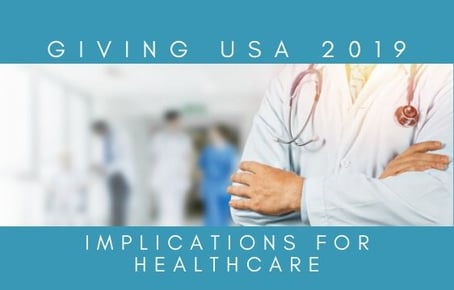According to Giving USA 2019: The Annual Report on Philanthropy for the Year 2018, American giving reached $427.71 billion in 2018, an increase of 0.7 percent in terms of current dollars but a decline of 1.7 percent from 2017, when adjusted for inflation. Even adjusted for inflation, charitable giving reached its second highest level ever in 2018, second only to 2017. Thus, 2018 is seen as a very strong but complex year in terms of philanthropy.
 What this Means for Healthcare Organizations:
What this Means for Healthcare Organizations:
Giving to health reached $40.78 billion in 2018. While growth over 2017 was nearly flat at just 0.1 percent (or declined by 2.3 percent when adjusted for inflation), the sector had its second highest level of giving ever when adjusted for inflation. Large gifts are common in this sector but donor retention lags behind other sectors. According to the Association for Healthcare Philanthropy’s 2018 annual Report on Giving, the largest sources of healthcare funds raised in 2017 were corporate/foundation and major gifts, followed by special events, annual gifts, and planned giving.
Online giving is becoming an increasingly popular way to donate to philanthropic organizations. While the healthcare sector does not see as many gifts coming from online resources as other sectors (5 percent as compared to 8.5 percent), Blackbaud Institute’s Charitable Giving Report found that online giving to the healthcare sector grew last year at more than twice the overall rate (3.3 percent as compared to 1.2 percent overall). Notably, the percentage of growth for online giving to medical research specifically fell by 2.5 percent. Donor retention following these online gifts to healthcare was lower than seen in other sectors. Indeed, according to the Benchmarks 2019 report by M+R and NTEN, the overall online retention rate was 37 percent while healthcare organizations had a 20 percent online retention rate.
Giving to healthcare is supporting more than patients’ physical well-being. Many large gifts are helping relieve the cost of treatment for patients and the large debts that hospitals often carry as a result of patients’ inability to pay for services. Healthcare philanthropy is also addressing social and environmental concerns in our communities that affect health, including the opioid crisis, an epidemic which has claimed over 400,000 American lives in the last twenty years according to the CDC. In spite of increased awareness on and emphasis on mental health, giving to mental health continues to be a challenge for the healthcare sector.
Suggested steps for improved fundraising results for health organizations:
- Focus on major gift donors as well as corporations and foundations. In the healthcare sector specifically, which tackles some of our society’s toughest and most pervasive challenges, large gifts dominate. Situate your organization to compete to receive these gifts by cultivating relationships with both individual major gift donors and corporate and foundation prospects. Be able to show and explain how your organization is addressing these large challenges – cancer, heart disease, mental and behavioral health, social determinants of health, etc. – and how large donations to your organization will move the needle on them.
- Continue to grow your online and social media presence. The lower rates of online giving and online donor retention in the healthcare sector mean that there is an opportunity for growth in this area. Make sure that your website is known, accessible, and sophisticated but easy to navigate. Don’t forget that, increasingly, visitors to your site will be using a mobile device, as opposed to a computer screen. Think about how your website and your options for donations are viewed on these devices. Your organization’s social media presence should be planned, engaging, and relevant. It should be a tool that your potential donors look to for issues that they care about and that spurs them to visit your website and to learn more about your organization.
- Consider the impact your organization is having on social determinants of health and whether that message is reaching potential donors interested in these issues. As noted above, healthcare organizations are taking a leadership role in terms of public health by addressing challenges including mental health concerns, the financial struggles families endure as a result of poor health, and the opioid epidemic. If your organization is taking on challenges like this in your community, you have an opportunity to reach potential donors committed to these issues. Make sure that your staff understands this opportunity and is able to articulate it to potential donors who may not be aware of your organization’s work in these areas. Marketing materials should also reflect the difference that your organization is making in terms of public health.
Source: Giving USA 2019: The Annual Report on Philanthropy for the Year 2018, published by Giving USA Foundation, a public service initiative of The Giving Institute, researched and written by the Indiana University Lilly Family School of Philanthropy.
![]()